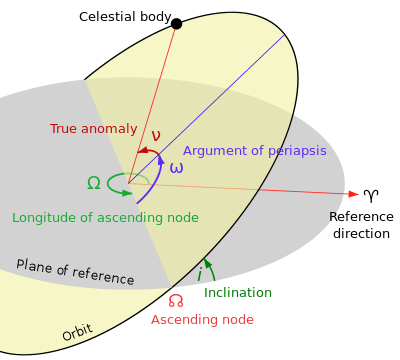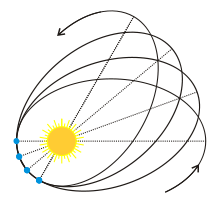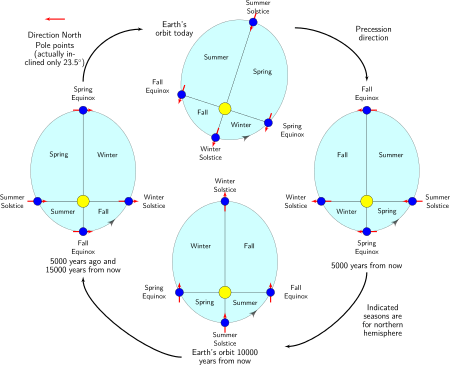Apsidal precession


In celestial mechanics, perihelion precession, apsidal precession or orbital precession is the precession (rotation) of the orbit of a celestial body. More precisely, it is the gradual rotation of the line joining the apsides of an orbit, which are the points of closest and farthest approach. Perihelion is the closest point to the Sun. The apsidal precession is the first derivative of the argument of periapsis, one of the six primary orbital elements of an orbit.
History
The ancient Greek astronomer Hipparchos noted the apsidal precession of the Moon's orbit;[1] it is corrected for in the Antikythera Mechanism (circa 80 BCE) with the rather exact value of 8.88 years per full cycle, correct within 0.34%.[2] The precession of the solar apsides was discovered in the eleventh century by al-Zarqālī.[3] The lunar apsidal precession was not accounted for in Claudius Ptolemy's Almagest, and as a group these precessions, the result of a plethora of phenomena, remained difficult to account for until the 20th century when the last unidentified part of Mercury's precession was precisely predicted in Albert Einstein's general theory of relativity.[4]
Calculation
There are a variety of factors which can lead to periastron precession, such as general relativity, stellar quadrupole moments, mutual star–planet tidal deformations, and perturbations from other planets.[5]
- ωtotal = ωGeneral Relativity + ωquadrupole + ωtide + ωperturbations
For Mercury, the perihelion precession rate due to general relativistic effects is 43″ per century. By comparison, the precession due to perturbations from the other planets in the Solar System is 532″ per century, whereas the oblateness of the Sun (quadrupole moment) causes a negligible contribution of 0.025″ per century.[6][7]
From classical mechanics, if stars and planets are considered to be purely spherical masses, then they will obey a simple 1/r2 force law and hence execute closed elliptical orbits. Non-spherical mass effects are caused by the application of external potential(s): the centrifugal potential of spinning bodies causes rotational flattening and the tidal potential of a nearby mass raises tidal bulges. Rotational and tidal bulges create gravitational quadrupole fields (1/r3) that lead to orbital precession
Total apsidal precession broadly in order of importance for isolated very hot Jupiters is (considering only lowest order effects)
- ωtotal = ωtidal perturbations + ωGeneral Relativity + ωrotational perturbations + ωrotational * + ωtidal *
with planetary tidal bulge being the dominant term, exceeding the effects of general relativity and the stellar quadrupole by more than an order of magnitude and thus can help us in understanding their interiors. For the shortest-period planets, the planetary interior induces precession of a few degrees per year and up to 19.9 degrees per year for WASP-12b.[8][9]
Newton's theorem of revolving orbits
Newton derived an early theorem which attempted to explain apsidal precession. This theorem is historically notable, but it was never widely used and it proposed forces which have been found not to exist, making the theorem invalid. This theorem of revolving orbits remained largely unknown and undeveloped for over three centuries until 1995.[10] Newton proposed that variations in the angular motion of a particle can be accounted for by the addition of a force that varies as the inverse cube of distance, without affecting the radial motion of a particle. Using a forerunner of the Taylor series, Newton generalized his theorem to all force laws provided that the deviations from circular orbits is small, which is valid for most planets in the Solar System.. However, his theorem did not account for the apsidal precession of the Moon without giving up the inverse-square law of Newton's law of universal gravitation. Additionally, the rate of apsidal precession calculated via Newton's theorem of revolving orbits is not as accurate as it is for newer methods such as by perturbation theory.


General relativity
An apsidal precession of the planet Mercury was noted by Urbain Le Verrier in the mid-19th century and accounted for by Einstein's general theory of relativity.
Einstein showed that for a planet, the major semi-axis of its orbit being , the eccentricity of the orbit e and the period of revolution T, then the apsidal precession due to relativistic effects, during one period of revolution in radians, is
where c is the speed of light.[11] In the case of Mercury, half of the greater axis is circa 5.79×1010 m, the eccentricity of its orbit is 0.206 and the period of revolution 87.97 days or 7.6×106 s. From these and the speed of light (which is ~3×108 m/s), it can be calculated that the apsidial precession during one period of revolution is = 5.028×10−7 radians (2.88×10−5 degrees or 0.104 arcseconds). In one hundred years, Mercury makes approximately 415 revolutions around the Sun, and thus in that time, the apsidal perihelion due to relativistic effects is approximately 43 arcseconds, which corresponds almost exactly to the previously unexplained part of the measured value.
Long-term climate
Because of apsidal precession the Earth's argument of periapsis slowly increases; it takes about 112000 years for the ellipse to revolve once relative to the fixed stars.[12] The Earth's polar axis, and hence the solstices and equinoxes, precess with a period of about 26000 years in relation to the fixed stars. These two forms of 'precession' combine so that it takes between 20800 and 29000 years and on average, 23000 years for the ellipse to revolve once relative to the vernal equinox, that is, for the perihelion to return to the same date (given a calendar that tracks the seasons perfectly).[13]
This interaction between the anomalistic and tropical cycle is important in the long-term climate variations on Earth, called the Milankovitch cycles. An equivalent is also known on Mars.
The figure illustrates the effects of precession on the northern hemisphere seasons, relative to perihelion and aphelion. Notice that the areas swept during a specific season changes through time. Orbital mechanics require that the length of the seasons be proportional to the swept areas of the seasonal quadrants, so when the orbital eccentricity is extreme, the seasons on the far side of the orbit may be substantially longer in duration.
See also
Notes
- ↑ Jones, A., Alexander (September 1991). "The Adaptation of Babylonian Methods in Greek Numerical Astronomy" (PDF). Isis. 82 (3): 440–453. doi:10.1086/355836.
- ↑ Freeth, Tony; Bitsakis, Yanis; Moussas, Xenophon; Seiradakis, John. H.; Tselikas, A.; Mangou, H.; Zafeiropoulou, M.; Hadland, R.; et al. (30 November 2006). "Decoding the ancient Greek astronomical calculator known as the Antikythera Mechanism" (PDF). Nature. 444 Supplement (7119): 587–91. Bibcode:2006Natur.444..587F. doi:10.1038/nature05357. PMID 17136087. Retrieved 20 May 2014.
- ↑ Toomer, G. J. (1969), "The Solar Theory of az-Zarqāl: A History of Errors", Centaurus, 14 (1): 306–36, Bibcode:1969Cent...14..306T, doi:10.1111/j.1600-0498.1969.tb00146.x, at pp. 314-17.
- ↑ Einstein, Albert. "Explanation of the Perihelion Motion of Mercury from General Relativity Theory" (PDF). Retrieved August 6, 2014.
- ↑ David M. Kipping (8 August 2011). The Transits of Extrasolar Planets with Moons. Springer. pp. 84–. ISBN 978-3-642-22269-6. Retrieved 27 August 2013.
- ↑ Kane, S. R., Horner, J., & von Braun, K. (2012). Cyclic Transit Probabilities of Long-period Eccentric Planets due to Periastron Precession. The Astrophysical Journal, 757(1), 105.
- ↑ Richard Fitzpatrick (30 June 2012). An Introduction to Celestial Mechanics. Cambridge University Press. p. 69. ISBN 978-1-107-02381-9. Retrieved 26 August 2013.
- ↑ Ragozzine, D., & Wolf, A. S. (2009). Probing the interiors of very hot Jupiters using transit light curves. The Astrophysical Journal, 698(2), 1778.
- ↑ Michael Perryman (26 May 2011). The Exoplanet Handbook. Cambridge University Press. pp. 133–. ISBN 978-1-139-49851-7. Retrieved 26 August 2013.
- ↑ Chandrasekhar, p. 183.
- ↑ Hawking, Stephen. On the Shoulders of Giants : the Great Works of Physics and Astronomy. Philadelphia, Pennsylvania, USA: Running Press. pp. 1243, Foundation of the General Relativity (translated from Albert Einstein's Die Grundlage der Allgemeine Relativitätstheorie, first published in 1916 in Annalen der Physik, volume 49). ISBN 0-7624-1348-4.
- ↑ van den Hewel, E. P. J. (1966). "On the Precession as a Cause of Pleistocene Variations of the Atlantic Ocean Water Temperatures". Geophysical Journal International. 11: 323–336.
- ↑ The Seasons and the Earth's Orbit, United States Naval Observatory, retrieved 16 August 2013